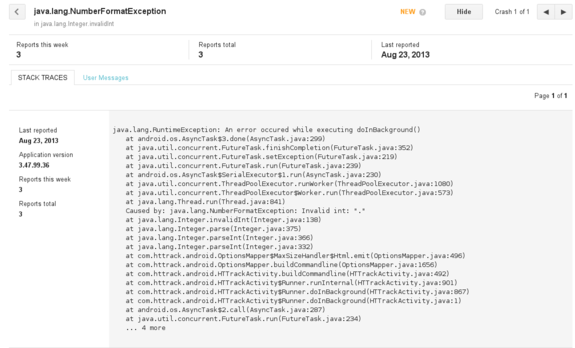Replacing JNI Crashes by Exceptions on Android
http://blog.httrack.com/blog/2013/08/23/catching-posix-signals-on-android/
To Report Or Not To Report
You have a nice application available on the Google Android Store and, as a developer, you have access to nice features giving you basic statistics (the number of downloads, Android version breakdown, etc.), reviews, and a Crashes & ANRs section allowing to audit user crash reports (and Application hangs – that’s the ANR thing).

This is a rather basic feature (you do not have any details on the user’s phone, Android version, etc. – only a Java stack trace extract), but at least it allows you to quickly spot mistakes (such as NullPointerException, or in this case, a NumberFormatException), and the report is pretty straightforward for users (they only have click on the “Report” button in case of crash)
But what if your application is using native code (through JNI) ? In such case, the application will just crash silently, giving the user no opportunity to report the bug to the upstream developer (you), which is not cool (because the bug will remain unspotted, unless users are nice enough to email you, and have the know-how to provide you useful technical details, such as the address of the crash, which is kind of rare)
Catching the Problem
A first step is obviously to be able to detect common native crashes (SIGSEGV, SIGBUS, etc.) using signal handlers. On POSIX systems, this can be achieved by using sigaction():
1
2
3
4
5
6
7
8
9
|
|
- First problem: we are typically running on small systems (Android …), and one source of error is the stack overflow. When the stack is full (too much recursion, too large objects on stack), you hit the last guard page, and the system will raise the
SIGSEGVsignal handler, running by default on the… same full stack, raising one more time the signal. Fortunately, you may register in any thread an alternative stack through the use ofsigaltstack, which basically reserve some space in case of emergency (ie. the system will switch the stack pointer to this one in case of trouble, letting you handler run on a “fresh” stack).
1
2
3
4
5
6
7
8
9
10
|
|
- Second problem: we’re hosted on a Java Virtual Machine, and some of these signals might already be caught. Typically,
SIGSEGVmight be regularly raised to addressNullPointerExceptionor as normal JIT processing (ie. executable pages might be flagged with a “no access” protection, and filled by the JIT compiler through a signal handler) – you have to make sure the original signal handler is called first, before messing up with it. If the signal was not processed, the original signal handler will generally return, or will callabort()(which is nice, because we have a last chance to catch it through aSIGABRThandler)
1
2
3
4
5
|
|
- Third problem: we’re running on a multi-threaded process, and ideally we do not want to catch crashes from threads we do not own. We can address this issue by using
pthread_getspecific()to have a thread-specific context. Well, this is actually a dirty solution:pthread_getspecific()is not an async-signal-safe function, which means that if you are using it on a signal handler, you may have to prepare for unforeseen consequences. (I fail to see what could go wrong with this specific function, however – this is just a peek in a thread-specific address array. But yes, yes, we’re playing with fire, don’t kick me!)
1
2
3
4
5
6
7
8
9
10
11
|
|
- Fourth problem: we have to collect some basic information on the crash, especially the faulting address. Fortunately, the third argument of the
sigactioncallback is a pointer to aucontext_tcontext collecting register values (and various other processor-specific details). On x86-64 architectures, the program counter will typically be saved inuc_mcontext.gregs[REG_RIP]; on ARM,uc_mcontext.arm_pc. Unfortunately, on Android, theucontext_tstructure is not defined in any system headers, and you’ll have to import one by yourself (I shamelessly copied the one from Richard Quirk). You also have to find out what was the binary where the program counter was actually running, to find out this code base address in memory, because a randomized address is not very useful for audit and debugging. The Linux-specificdladdr()function is fortunately giving you this information, with useful other ones (namely the nearest symbol matching the address, and the module base address, to compute a relative offset address). (Note: you can also get this information on Linux by snooping in/proc/self/maps, and checking the address ranges – it will at least provide you the base address)
1
2
3
4
5
6
7
|
|
You have also the opportunity to catch a backtrace, with the same information, as long as you have a recent (ie. 4.1.1 or higher) Android version, using libcorkscrew library features. This library is not available on older Android releases, and besides, we do not want to get a backtrace of the current stack, but a backtrace of the stack provided in the crash context. Fortunately, we can dynamically load the libcorkscrew.so library to solve the first issue (using dlopen and dlsym()) and, for the second issue, import manually a nice function called unwind_backtrace_signal_arch, which does exactly what we want:
1
2
3
4
5
6
7
8
9
10
11
12
|
|
(We also need to import acquire_my_map_info_list())
We can also, when corkscrew is there, use the advanced get_backtrace_symbols function to resolve symbols and demangle them:
1
2
3
4
5
6
7
8
9
10
11
12
13
14
15
16
17
18
|
|
- Fifth problem: you need to pass all these useful information back to the Java Virtual Machine, and not only by calling directly some kind of callback, because you need to propagate a clean
RuntimeExceptionand unwind all Java frames, to have your final exception being reported through the Android framework. The only way to achieve that is by storing the exit point in your own code, usingsetjmp(actuallysigsetjmp, because we’ll need to restore some masked signals), and using it in your signal handler to directly jump at the correct location. Thesigsetjmp/siglongjmpfunctions are obviously not async-signal-safe (see the remark on Application Usage ofsigaction()), so this is a highly risky bet. Typically, if the crash happened in the middle of amalloc()call (because, say, the linked list of free blocks has been corrupted), you may find yourself triggering anotherSIGSEGV(which is the lesser of the evils) or worse, deadlocked, which is rather embarrassing because the user will have to find a way to kill the application by himself. For this reason, analarm()call will be the first operation executed in case of emergency (and yes,alarm()is async-signal-safe – we can safely kill ourselves).
1
2
3
4
5
6
7
8
9
10
11
12
13
14
15
16
17
18
19
20
|
|
Is It Working ?
Yes, and it’s much nicer to have SIGSEGV advertised through a clean stack:
1
2
3
4
5
6
7
8
9
10
11
12
13
14
15
16
17
18
19
20
21
22
23
24
25
26
27
28
29
30
31
32
33
34
|
|
Bonus: produce a relative address, and get the filename and line number for FREE!
In the above stack, we know that the crash occurred somewhere inside the hts_main2 function, which is not very precise. We have actually another very useful information: the crash was spotted inside libhttrack.so, at the relative address 0xa024. This is a relative address, computed earlier with dladdr(), which means that you can find out exactly the source location if you kept some debugging information. Most people do not want them, because it increases the binary size by a unreasonable factor (especially when running on small embedded devices with 3G+ connectivity priced above gold ingots levels), and thus either strip them silently, or keep another “debug” build.
You have an extremely simple alternative way: build once your libraries with all debugging symbols, including line numbers and macro information (-g3), and instead of stripping them, split the debugging sections on a separate file (say, a .dbg file). To let various tools such as gdb or addr2line behave gently, you have a way to “tell” them that the .so actually has a debug .dbg related file, through the .gnu_debuglink ELF section.
Here’s what you typically need to do to split your library into a stripped version plus a debug symbol file:
1
2
3
4
5
6
7
8
|
|
The nice .dbg file can then be kept for debugging purpose:
1
2
3
4
|
|
Okay, but Is It Really Safe ?
A typical crash may have a great variety of causes (Captain Obvious to the rescue!). My own experience, though, shows that NULL pointer dereferencing, dangling pointers, and other isolated crash spots due to bad code logic are a very common cause of crashes. Yes, you will still have troubles when dealing with corrupted allocators, or when breaking in the middle of a async-signal-safe call (leaving mutexes locked, and more generally a dirty state that will hit you back later), but the alternate solution is to die immediately (the default behavior), so trying to do gentle emergency steps can not do any harm.
I Want To Test It!
You can check out the “CoffeeCatch” library code on GitHub – you can either merge the .c file in your project(s), or build it as a standalone library ; this tiny library has no exotic external dependencies. Make sure all your libraries are built with the -funwind-tables compiler flag to produce frame unwind information for all functions (add if necessary LOCAL_CFLAGS := -funwind-tables to your Android.mk file). Note that -funwind-tables does not produce significant data size overhead in normal situations – so rest well my friend.
The use is pretty straightforward – for JNI code, a simple macro COFFEE_TRY_JNI, taking the JNIEnv environment pointer as a first argument, and a code block as a second argument, will do the trick. For code outside JNI, you have to enclose protected code with COFFEE_TRY()/COFFEE_CATCH()/COFFEE_END() as in the example below.
In all cases, make sure the block is enclosed in a dedicated function without any local variables lying around (because the saved context does not include registers, AFAIK, especially volatile registers, which might be wiped before calling sigsetjmp, and whose saved values are in unknown location in the stack).
The JNI flavor:
1
2
3
4
5
6
7
8
9
10
11
12
13
14
15
16
17
18
19
|
|
The standard flavor:
1
2
3
4
5
6
7
8
9
10
|
|
TL;DR: so far, no native crash has been reported on Android for HTTrack. But I’m ready to collect them in case of need :)
支付宝扫一扫捐赠

微信公众号: 共鸣圈
欢迎讨论,邮件: 924948$qq.com 请把$改成@
QQ群:263132197
QQ: 924948




